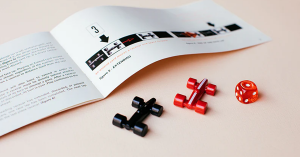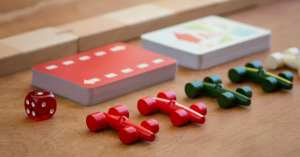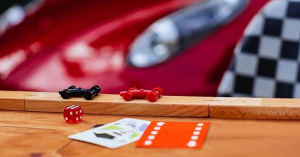Lacorsa Grand Prix Game Draws from Racing History and Classic Design
Lacorsa Grand Prix Game is a board game centered on Formula One racing. As one of the few motor racing board games grounded in historical detail and strategy.
LAGUNA BEACH, CA, UNITED STATES, July 25, 2025 /EINPresswire.com/ -- Lacorsa Grand Prix Game is a board game centered on Formula One racing. As one of the few motor racing board games grounded in historical detail and strategy, it offers more than just speed. The game incorporates visual and mechanical elements based on real-world motorsport. It includes a set of rules, a race track, race car game pieces, and decision-based movement systems.The game's structure reflects the development of racing strategies. Players manage power, speed, overtaking, and track position. Each decision influences subsequent outcomes. The system emphasizes tactical movement over random chance.
Visual design is a key aspect. The game avoids modern photo-based artwork. Instead, it employs a graphic art style inspired by vintage racing posters. The posters that influenced the look were created for the Italian Grand Prix in the 1940s, 50s, and 60s.
Printed materials follow design principles from that era. The rulebook features classic grid layouts, and the typeface is Univers, a font by Adrian Frutiger commonly used in Swiss print design. These choices reflect design trends of mid-20th-century Europe.
The cars in the game are based on late 1960s Grand Prix vehicles. Real racing models inspire their shapes, though some proportions are drawn from a 1970s-era Ferrari 312T.
Each car uses national racing colors as a reference. Red represents teams like Ferrari, Alfa Romeo, and Maserati. British Racing Green is associated with makes like Lotus, Brabham, and Cooper. Racing White was initially used by Mercedes and was later adopted by Honda in the 1960s. You find it as one of the three original colors in the Lacorsa Grand Prix Game.
The track and materials are designed to support various race scenarios. Cars can pass each other, fall behind, or stay in groups to conserve resources. Some will push early and lose power later, while others will conserve to gain an advantage near the end. The best strategy is to start from pole position and keep a gap until the finish. The system handles all these tactics.
Design Approach Uses Motorsport Culture Without Replication
The person behind the game’s design is Mark Haskins. His goal was to blend the feel of classic motorsport with a clear visual style. He didn’t want to copy any one race or car. Instead, he gathered details from different eras of racing and combined them into a unified design.
One goal was to create a board that captures the energy of racing posters. Mark was inspired by the work of Max Huber and others who made Grand Prix posters during the post-war decades. These posters featured bold lines, vivid colors, and clean layouts. They avoided photos, instead using shapes and type to suggest speed and excitement. This approach influenced the game’s design.
The race cars in Lacorsa are not exact replicas. They are shaped and colored to evoke a certain era and style without matching any specific car. This allows the design to represent an entire era. The idea was to create cars that could have been imagined in the past, inspired by futuristic concepts, making them solid like race car chess pieces.
While the system encourages clever gameplay and planning, it doesn’t require expert-level knowledge. That’s why Lacorsa games for kids work well too—children can enjoy racing thrills while gradually learning more complex tactics across multiple sessions.
Even the rulebook reflects these ideas. It features a grid-based layout and typography inspired by old design manuals. The fonts are kept simple and clear. The layout leaves space between sections. These choices were made not to appear modern, but to remain true to the period style used throughout the game.
The game also avoids modern branding or licensed marks. There are no logos from actual teams or tracks. The names and symbols are original. The goal was to let the game stand independently without tying it to specific motorsport brands.
About the Lacorsa Grand Prix Game
Lacorsa Grand Prix Game is a tabletop board game focused on the international racing series. Among modern Grand Prix racing games, it stands out for its attention to period design and gameplay that balances pace, positioning, and psychology.
Motorsport culture, graphic design principles, and race strategy influence its development. Visual elements are inspired by European poster design from the 1940s to the 1960s. Gameplay systems rely on momentum, timing, and variable outcomes.
No part of the game is linked to an existing racing series or official race data. However, it takes inspiration from historical car styles, realistic strategy, and race formats, like a championship of seven races, to create an authentic feel.
Lacorsa does not require advanced strategy knowledge. Basic rules can be learned quickly. Yet, repeated play uncovers more complex choices and interactions. The game caters to players interested in pacing, tactics, track decisions, and card play. The game contains no digital components. All materials are physical.
The design was led by Mark Haskins, whose work combines design research and motorsport history. His goal was to create a system that appears and feels consistent with the period, without using direct reproductions or licenses.
Lacorsa Grand Prix Game is available through select board game retailers and online platforms. For more information, materials, and resources, please visit the official website.
Contact Us: info@lacorsagame.com
LaCorsa Grand Prix Game
LaCorsa Grand Prix Game
+ 1 949-374-1647
info@lacorsagame.com
Visit us on social media:
Instagram
Facebook
YouTube
Legal Disclaimer:
EIN Presswire provides this news content "as is" without warranty of any kind. We do not accept any responsibility or liability for the accuracy, content, images, videos, licenses, completeness, legality, or reliability of the information contained in this article. If you have any complaints or copyright issues related to this article, kindly contact the author above.




